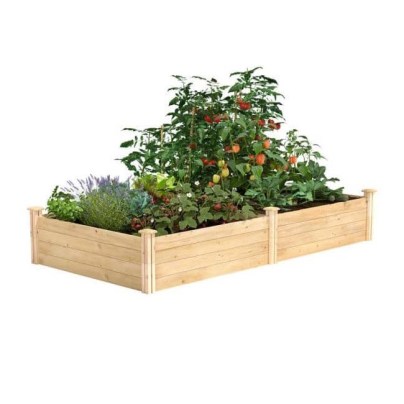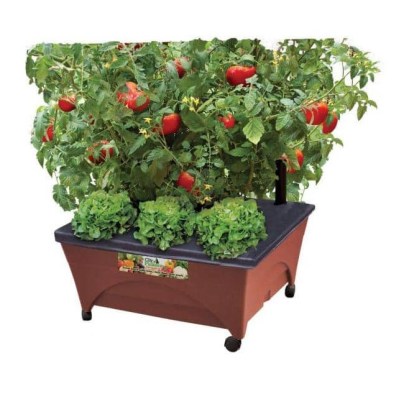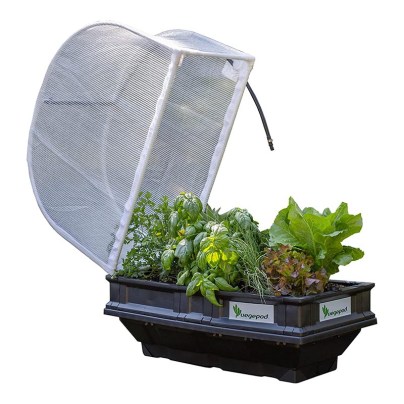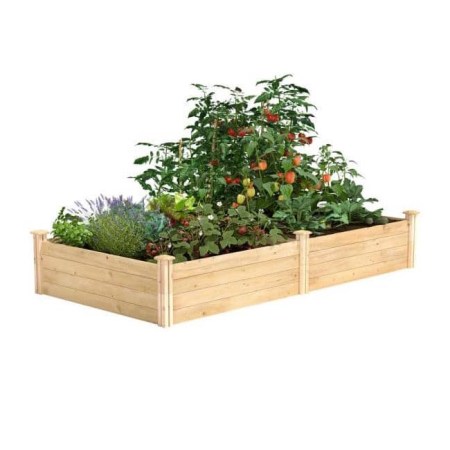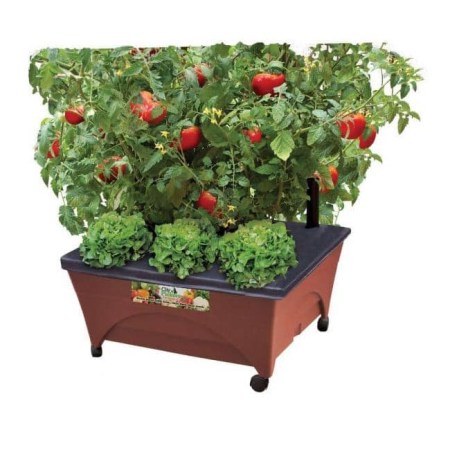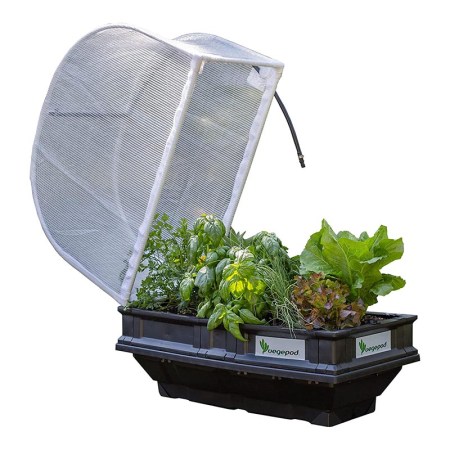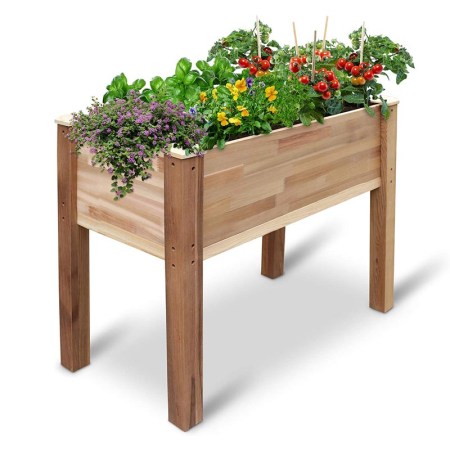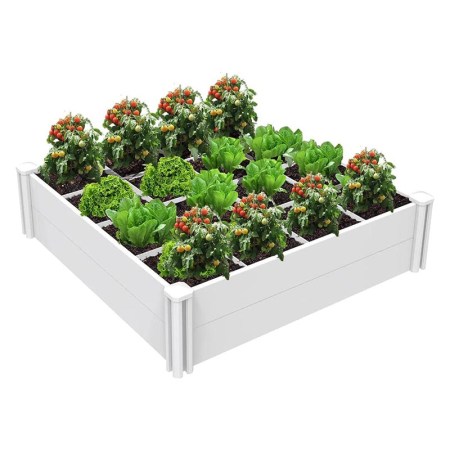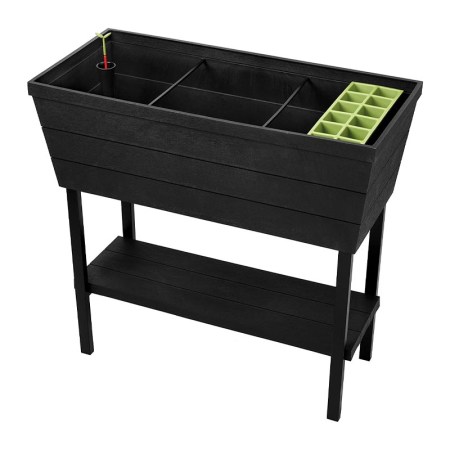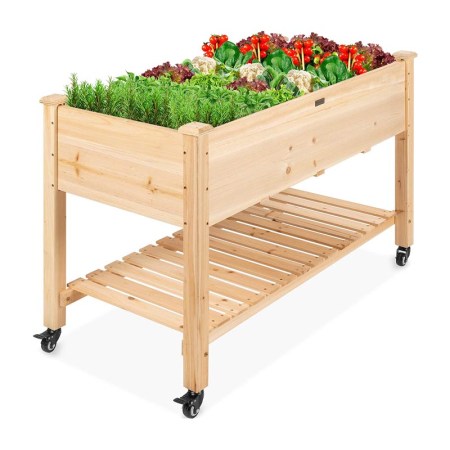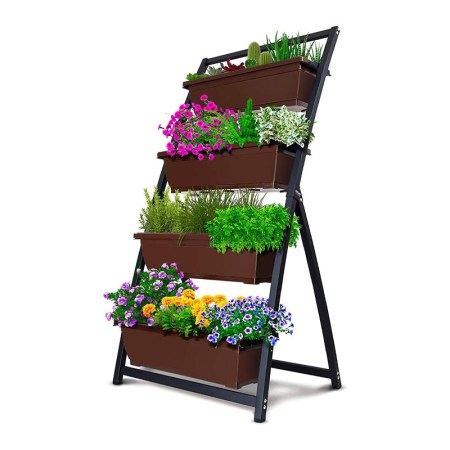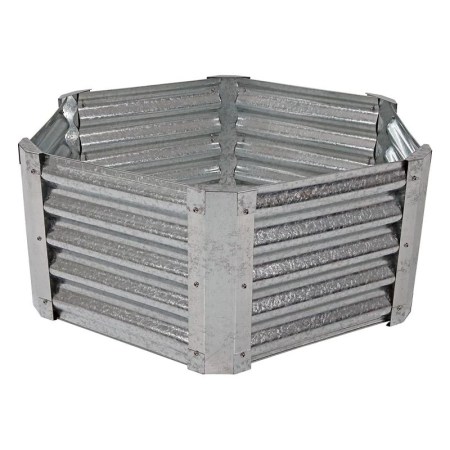We may earn revenue from the products available on this page and participate in affiliate programs. Learn More ›
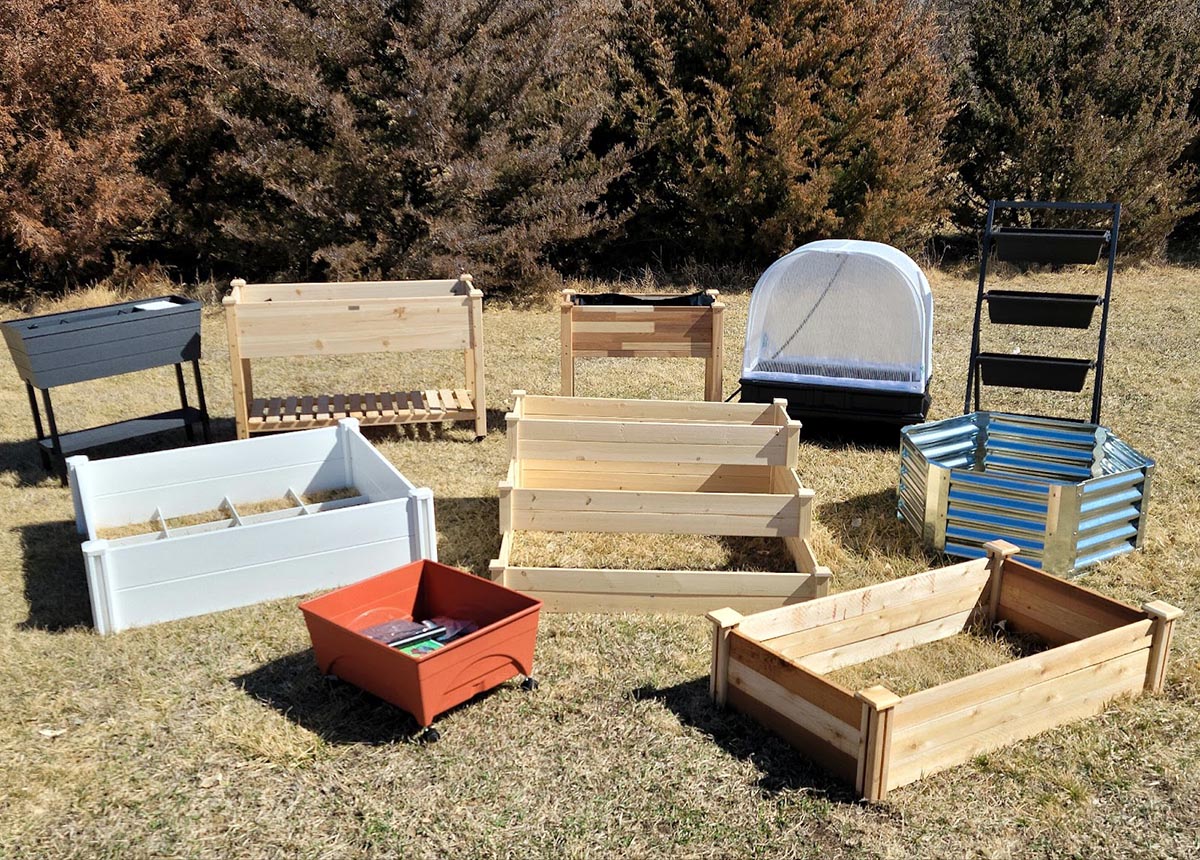
Raised-bed gardening is a popular option for many backyards. It allows users to put a garden practically anywhere, even if the yard isn’t suitable for installing a traditional ground-level garden. Raised beds are touted as back savers since they reduce the distance the gardener needs to bend to tend to the plants. But how helpful are they, really? Without personally testing the beds, we couldn’t tell whether they contained quality materials, were designed for optimal plant growth, or if they would be overly challenging to assemble.
So, we decided to test them. We assembled nearly a dozen raised garden beds (no, they don’t come assembled), and then we put them through a battery of gardening-specific tests. Unfortunately, not all the raised garden beds survived our stringent testing; you can find out about one that didn’t make it just ahead.
We interviewed other garden experts to get additional insight, and in general, we discovered that raised beds offer several advantages. They provide better drainage than ground-level gardening. They also are less prone to soil compaction, but this depends on the soil mix used to fill the raised bed.
Since every garden can be different, there is no “standard” when it comes to raised garden beds. Picking the best raised garden bed will depend on space limitations, physical comfort, design, and the type of plants grown. Keep reading to learn how to pick the best raised garden bed for your backyard, and find out why the following models all earned a spot in this lineup of some of the best raised garden beds for backyard plants.
- BEST OVERALL: Greenes Fence Cedar Raised Garden Bed
- BEST BANG FOR THE BUCK: City Pickers Patio Raised Garden Bed
- BEST WITH COVER: Vegepod Raised Garden Bed
- BEST FOR PATIO: Jumbl Raised Canadian Cedar Garden Bed
- BEST HERB GARDEN: Kdgarden Raised Garden Bed Kit
- BEST FOR BEGINNERS: Keter Urban Bloomer 12.7-Gallon Raised Garden Bed
- BEST WITH WHEELS: Best Choice Products Raised Garden Bed
- BEST FOR TALL SPACES: Outland Living Vertical Raised Garden Bed
- BEST FOR BACKYARDS: Sunnydaze Raised Metal Garden Bed Kit
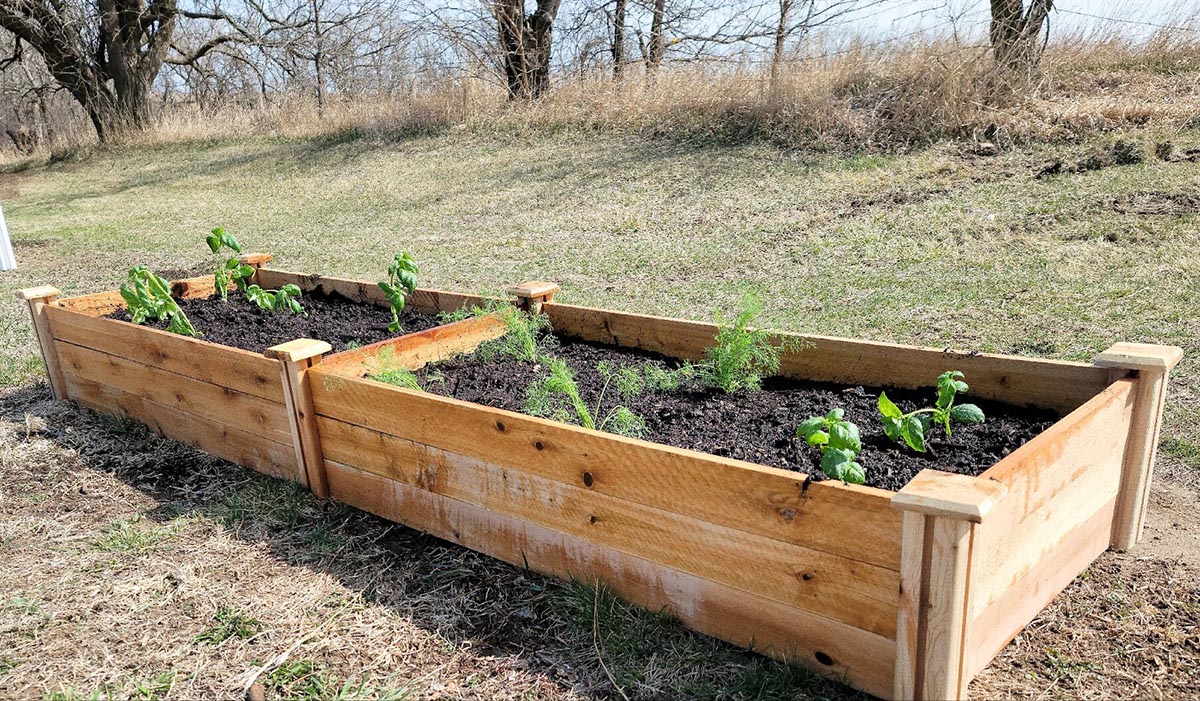
How We Tested the Best Raised Garden Beds
We spoke to David Angelov, a master gardener and founder of PlantParenthood, a gardening design and maintenance service based in Newton, Massachusetts. He recommends springing for a robust construction such as hardwood: “Other than longevity for the beds and sustainability of the materials, there’s impact on the health of your crop and the ability to eat your crop. This may be most often more expensive, but it’s worth it in every case I’ve used.” He adds that “if you use something like pressure-treated wood loaded with chemicals, there is a risk of that seeping into the water that feeds your food.” We took this advice in mind when choosing the products to test.
Our goal in testing the raised garden beds was to cut through the hype and determine each bed’s real pros and cons so readers could take advantage of our results before buying.
We used a rubric and awarded points for each feature we tested on the garden beds. The individual tests included noting the ease of assembly, judging the overall stability and quality of the materials of each raised bed, filling the beds with potting soil, and then testing to see how well they drained.
Filling them with soil and then watering them was essential because wet soil is heavy and creates a substantial amount of lateral pressure. A flimsy raised bed is a waste of our readers’ money no matter how attractive it is. We added a few plants here and there, mainly for photos, but we tested the beds in late winter when nighttime temps were still too cold to permanently plant the beds.
We also analyzed the design of the beds and awarded extra points for helpful features, such as the water-level indicator on the Keter raised bed that made it especially helpful for those who are new to raised bed gardening.
After the testing was complete, we added the scores and used the results to assign relative awards for each product. We detailed both the pros and the cons, so our readers would have a heads-up on what to expect if they purchase one of these top-performing raised garden beds.
Our Top Picks
The following models passed our stringent performance tests to earn a spot in this lineup of some of the best raised garden beds. They had to be durable enough to support the weight of the soil mix, and they had to be designed so that plants had both root space and adequate drainage. Each one also had to live up to the seller’s claims, for the most part.
While the following raised beds differ in size, material, and design, making some better suited for specific growing situations, each one was a standout in our tests and has earned its place among the best raised bed gardens available today.
Best Overall
Greenes Fence Cedar Raised Garden Bed
See ItProduct Specs
- Estimated assembly time: 25 minutes
- Material: Cedar wood
- Drainage: Excellent
Pros
- Cedar is naturally insect- and water-resistant; perfect for gardening
- Boards are sturdy enough to support the weight of wet soil easily
- Attractive and well designed; looks great in most gardens
Cons
- Included screws are too wide for end caps; makes installation more difficult
We were excited to open the box that the Greenes Fence cedar raised garden bed came in and put it together. Cedar is a naturally weather-resistant wood, and there was no question that it was natural cedar—the fresh aroma of the wood confirmed it.
The side and end boards slide into the corner posts via dovetail-type slots. Most went in fairly easily, although a few required tapping with a mallet to get them to slide in the slots. Cedar caps added a nice finishing touch to the tops of the posts—and the screws are included—but we found they were slightly large and prone to split the wood, so we used #8 self-tapping screws to reduce the risk of the wood splitting.
The kit features durable 11/16-inch-thick boards, which we found to be about the right thickness. We placed the 4-foot-by-8-foot Greenes garden bed on a level section of the yard and then filled it with potting soil. The bed held up well to the pressure of the soil even after we wet the soil, which increased its weight and lateral pressure.
Since this raised bed is open on the bottom, it drains freely, making it well suited for fruits, vegetables, and flowers that require ample drainage. The sides are 14 inches high, which is just about right for pulling an occasional weed or picking a ripe green pepper without back strain. We were impressed with the quality of this raised bed, and it looks sharp, too.
Get the Greenes Fence raised garden bed at Lowe’s, The Home Depot, or Tractor Supply Co.
Best Bang for the Buck
City Pickers Patio Raised Garden Bed
See ItProduct Specs
- Estimated assembly time: About 2 minutes
- Material: High-density polyethylene
- Drainage: Drains well from holes on sides
Pros
- Budget-friendly option; ideal for beginner gardeners
- Compact size is small enough for patio or balcony
- Mulch cover reduces evaporation; great for delicate plants
Cons
- Only one mulch cover comes with the bed; will likely require more over time
The City Pickers Patio raised garden is designed for growing a couple of tomatoes, a few lettuce plants, or a handful of herbs. Right off the bat, we loved the price, which is very affordable compared to the other beds we tested, and the design is well thought out. Even better, there’s minimal assembly with this raised bed.
The City Pickers garden bed comes with a one-piece molded-polyethylene tub that holds a drain rack in the bottom and has a spot for a watering tube on one inside corner (rack and tube included). The only actual assembly involved attaching the caster wheels to the bottom, but a quick push and they were in place. They roll smoothly, and it was simple to push this garden bed from one spot on the patio to another.
Next, we filled it with potting soil and saturated it. The bottom of the tub holds 2 gallons of water, and the rack keeps the soil mix from falling into the water reservoir. At first, we were unsure whether the tub had drainage holes, but then we saw water trickling out the sides, near the bottom. The holes are there—the tub design just camouflages them.
The City Pickers tub is 2 feet long by 20 inches wide and 9.5 inches deep. That’s a bit on the shallow side when growing plants that require ample water (because it can evaporate quickly), but the manufacturer figured out a way to reduce evaporation—with a fiber-mulch liner that fits neatly over the top of the tub and ties to secure it in place. The fiber keeps the soil from drying out quickly, which is a big plus. While it’s the least expensive of the models we tested, we were impressed by the level of detail that went into designing the City Pickers garden bed.
Get the City Pickers raised garden bed atThe Home Depot or BuildClub.
Best with Cover
Vegepod Raised Garden Bed
See ItProduct Specs
- Estimated assembly time: 35 minutes
- Material: High-density polyethylene
- Drainage: Tiny holes we felt were inadequate
Pros
- With the top installed, it creates a microclimate
- Cover helps keep plants protected on chilly nights
- The misting hose connects to a garden hose for spraying plants
Cons
- Does not drain quickly enough after it rains; may need additional drain holes
The Vegepod is more like a mini-greenhouse than a simple raised bed. While it claims to be “self-watering,” it isn’t. At the bottom of the bed is a water reservoir that is made to be filled with perlite. The perlite acts as a wick to transfer the water to the soil above, which is what the company means by “self-watering.” We were concerned about plants getting “wet feet” due to soggy soil at the bottom because the Vegepod doesn’t drain well. We found only a couple of tiny drain holes.
Assembly is relatively complex on this one. No tools are needed, but the product comes in more than a dozen sections that must be aligned and connected. The instructions are pretty inadequate, so we had to use some trial and error until we finally got it right.
Buyers should know that the legs that elevate the bed to waist height must be purchased separately—they were not included with the small model we tested. However, it’s still a robust raised bed, and with the protective cover, it can easily extend the growing season.
The Vegepod is a high-end raised bed that would be well suited to growing late fall or early spring produce. However, we recommend keeping it under a protected patio cover. We put it on an open section of the patio, and it rained. The perforated cover let quite a bit of the rain in, resulting in soppy wet soil that took hours to drain. We ended up drilling a couple of drain holes along the side to help the water drain out.
A handy feature on this model is a misting hose that installs along the inside top of the cover. We connected the misting hose to our garden hose, and when we turned it on, the mister evenly sprayed the plants inside. The Vegepod is 20 inches long, 13 inches wide, and with the cover installed, stands 40 inches high. It weighs 22 pounds, which was heavy enough to keep it from sliding across the patio during a storm with high winds.
Get the Vegepod raised garden bed at Amazon, The Home Depot (large size), or Gardener’s Supply Company.
Best for Patio
Jumbl Raised Canadian Cedar Garden Bed
See ItProduct Specs
- Estimated assembly time: 20 minutes
- Material: Cedar wood
- Drainage: Natural, between wood slats
Pros
- Longer legs brings this bed even higher; great for people with back issues
- Made from high-quality cedar; sturdy and durable
- Wood could be painted to match a particular outdoor design
Cons
- Some slats were too long and had to be cut to fit
Our impressions of the Jumbl raised garden bed are that it is made of solid, quality cedarwood and is well designed. Some assembly is required, and, unfortunately, a couple of the bottom bed slats were slightly too long, so we had to shave off just a bit to get them to fit. All in all, though, this is a good-quality raised bed for the price. Be aware that natural wood can swell or contract slightly due to humidity changes, and this is normal.
The legs are milled from a single post of cedar, which eliminates joints between the bottom of the bed and the legs. This makes the unit sturdy and solid. We positioned it on the paved patio, and it didn’t wobble, not even a little bit. The Jumbl bed is 18 inches wide and is 34 inches long. The inner bed depth is just under 9 inches, offering satisfactory room for root development of herbs, many types of flowers, and leafy-type veggies.
The bed came with a fiber-mulch liner that helps retain the tiny bits of potting soil that would have otherwise washed out the bottom between the wood slats when the water naturally drains away. One of the nicer features is the dowel assembly that holds the top post caps on. Without the need to insert screws, there is less risk of the screws corroding and discoloring the cedar. The Jumbl bed is large enough to grow various small veggies or flowers, and it looks good enough to put out in the open.
Get the Jumbl raised garden bed at Amazon, Lowe’s, or Target.
Best Herb Garden
Kdgarden Raised Garden Bed Kit
See ItProduct Specs
- Estimated assembly time: 5 minutes
- Material: High-quality PVC
- Drainage: Naturally, under the bottom of the side rails
Pros
- Easy to assemble in as little as 5 minutes
- Made using rot and insect resistant materials
- Top grid for separating small plants helps keep things organized
Cons
- The bright white is quite noticeable (some may like this)
The Kdgarden raised garden bed is slightly different from the other beds we tested in that it’s made from heavy-duty white PVC, and all the pieces have been manufactured to fit together perfectly. Assembling this raised bed was refreshingly straightforward.
The Kdgarden measures 48 inches long by 48 inches wide and stands 13.3 inches high, offering plenty of room for flower and vegetable plant-root development. We positioned it on a level section of ground, and excess water drained out without a hitch from under the bottom side rails.
This raised bed could be used to grow a large crop of lettuce or other vegetables, but we found it better suited to growing smaller plants, such as herbs. It comes with a grid that fits along the top edge that provides 16 smaller growing spaces. The PVC material will not rot, and it’s impervious to insect infestations. The white color is rather bright and visually stands out in the yard, but it would be right at home in the yard of a white house or a house with white trim.
Get the Kdgarden raised garden bed at Amazon.
Best for Beginners
Keter Urban Bloomer 12.7-Gallon Raised Garden Bed
See ItProduct Specs
- Estimated assembly time: 15 minutes
- Material: High-density polyethylene
- Drainage: Plug located at the bottom of the bed
Pros
- Good height for mobility challenged gardeners
- Water-level indicator helps prevent overwatering
- Drainage plug great during particularly dry seasons to lock in moisture
Cons
- Would be nice if it had wheels; difficult to move if required
One of the biggest challenges for newbie gardeners is learning when and how much to water their plants. With some raised beds, that can be an issue even for seasoned gardeners if they can’t determine how much moisture is in the bottom of the bed.
The Keter Urban raised bed takes all of the guesswork out of watering. It features a vertical tube that runs from the top of the bed to the bottom of the water tray. Inside the tube is a cute little plastic flower that rises with the water level. We found this to be an ingenious way of letting the gardener know when it is time to water or when the water reservoir is full and needs draining. After we filled up the bed with potting soil, we watered, and, sure enough, the little plastic flower poked its head out of the tube to let us know we could stop.
A drainage plug is located on the bottom of the bed, which makes it easy to drain away excess water. Another handy feature is the molded plastic seed-starting tray that can be filled with potting soil and then positioned on the top of the bed.
The Keter Urban raised bed stands 30 inches tall, is 32 inches long, and is 14 inches wide. Inside the bed are six 12-inch-deep planting boxes that will keep roots from becoming entangled. Another nice feature is a rack that sits under the bed and will hold an array of trowels and gardening supplies. This little gem offers everything a new gardener needs to get started.
Get the Keter raised garden bed at Amazon, Walmart, or Bed Bath & Beyond.
Best with Wheels
Best Choice Products Raised Garden Bed
See ItProduct Specs
- Estimated assembly time: 20 minutes
- Material: Fir wood
- Drainage: Naturally between wood slats
Pros
- Looks great; quality artistry and using natural fir wood
- Well designed with handy storage shelving underneath the bed
- 4 wheels make this very easy to move around
Cons
- Only 1 liner comes with the bed; will likely require more
One word accurately describes the Best Choice Products raised garden bed: quality. This is another wood bed that requires assembly, but it’s made from rot- and insect-resistant fir that’s been carefully cut and milled. All of the slats, side sections, and bottom rail were easy to put together, and they fit like a glove; no mismatched wood here.
The Best Choice Products raised bed is pretty large for an elevated wood bed and is a full 48 inches long by 23 inches wide by 32 inches tall. The inner planting bed is about 9 inches deep. At this size, it would be difficult to move the unit by hand once it was filled with plants and wet soil. Fortunately, the manufacturers included quality locking wheels that rolled smoothly but locked securely to keep the bed from shifting.
The Best Choice Products bed comes with a fiber-mulch liner that helps keep the potting soil from trickling out from between the bottom slats. It’s a great feature, but the liner probably wouldn’t be reusable after a few months. Buyers should plan on purchasing more fiber mulch to cut and make new liners each season.
This is a well-engineered raised bed, and it’s made even handier by the inclusion of a wood rack under the bed. We used the rack to hold gardening tools and a large bag of potting soil.
Get the Best Choice Products raised garden bed at Amazon, The Home Depot, Walmart, or Target.
Best for Tall Spaces
Outland Living Vertical Raised Garden Bed
See ItProduct Specs
- Estimated assembly time: 20 minutes
- Material: Steel frame, polyethylene containers
- Drainage: None
Pros
- Sturdy steel frame can last several years
- Attractive design works well on balconies or patios
- Allows users to grow numerous plants in small, vertical space
Cons
- Containers do not have drainage holes; users may need to drill some themselves
We didn’t know what to expect when we opened the Outland Living raised garden bed—the box was full of steel legs and frame members and four heavy-duty polyethylene containers.
The assembly took more than 30 minutes on this one but only because we put the braces on wrong the first time and had to take them off and then reassemble them correctly. It would have saved us at least 10 minutes if we had studied the instructions. Assembly isn’t difficult; it’s a matter of attaching the steel legs and frame members with stainless steel nuts, washers, and bolts (all included).
Once assembled, the Outland Living frame stands 50 inches tall, is 25 inches from side to side, and is 19 inches from front to back at the base. We wondered if the unit would be sturdy enough, but we need not have. It’s well balanced, and after a high-wind storm, it was still standing upright.
The four containers fit securely on the frame’s side braces, and they’re large enough to hold compact flowers and herbs. One downside is that the containers do not come with drainage holes, so we drilled some in the bottom of each container after we found the plants floating in water following a rainstorm.
Minus the drainage issue, the Outland Living raised vertical bed is a winner. It’s attractive, and it allowed us to grow multiple small plants in a narrow spot.
Get the Outland Living raised garden bed at Amazonor Walmart.
Best for Backyards
Sunnydaze Raised Metal Garden Bed Kit
See ItProduct Specs
- Estimated assembly time: 25 minutes
- Material: Galvanized steel
- Drainage: Naturally from underneath (where panels meet)
Pros
- Ample root space with a 16-inch-deep bed; ideal for larger plants
- Galvanized steel won’t rust or corrode
- Very easy to assemble compared to other products in the lineup
Cons
- Water tends to run out between panels
The Sunnydaze raised metal garden bed isn’t going to win any awards for its looks—in fact, it closely resembles a galvanized livestock tank—but it is a front-runner when it comes to growing plants.
Although assembly was straightforward with this hexagonal metal bed, a number of fasteners—six bolts, nuts, and washers—are necessary for every vertical support, so that took up quite a bit of assembly time. We spent probably 25 minutes putting it together. Once assembled, the Sunnydaze is strong, resilient, and made to last. The galvanized steel resists rust and corrosion, and the planter is 40 inches across. Its 16-inch depth makes it well suited for growing deep-rooted plants, such as watermelons or pumpkins.
We positioned the Sunnydaze on a level section of ground and filled it with potting soil. When we first watered the bed, we saw some drainage out of the sides where the metal sections were attached to the supports. We shoveled and tamped the growing mix in those spots and watered again. We didn’t see the water running out from behind after that.
The Sunnydaze holds a good amount of potting soil, and users can easily grow three large vining plants or up to a dozen smaller, more compact plants. We found that putting a small sprinkler in the very middle of the bed was an optimal way to water. We would avoid sticking a hose in and just let the water run freely to keep from creating a dug-out area near one of the sides that would allow the water to run out again.
ALSO TESTED
Get the Sunnydaze raised garden bed at Amazon, Lowe’s, Tractor Supply Co., The Home Depot, or Target.Patiomore 3-Tier Raised Garden Bed Initially, we had high hopes for the Patiomore three-tier raised garden bed.It was the only tiered bed we were testing, and we thought it would be perfect for growing strawberries. Unfortunately, we were wrong. As we unpacked the box full of slats and corner posts, we noticed they were thinner and flimsier than those of other wood beds we’d already assembled. Plus, although the manufacturer said the wood was fir, it looked a whole lot like pine. But, hoping for the best, we assembled the bed. Once assembled, it was precarious just moving the Patiomore garden bed to the center of the yard so we could photograph all of the raised beds together—the bottom side slats kept falling out. We finally figured out how to secure it with straps and get it tipped up on a hand truck to move it. After the group photo, we positioned it on a level section of ground and filled it up with potting soil. The bottom slats on the back right corner started bulging slightly, but they held. We watered the potting soil and called it a day and planned to plant a few strawberries in the morning. Morning came with an unwelcome surprise—the bottom slats on the back right corner had blown out, ostensibly due to the lateral pressure from the wet potting soil. The Patiomore bed was a loss, and we eliminated it from testing at that point.
Jump to Our Top Picks
What to Consider When Choosing a Raised Garden Bed
With so many options on the market, it can be tough to decide on the right raised garden bed. Comparing some of the key features such as material, size, and assembly requirements that most garden beds offer and considering your gardening goals, space, and design scheme can make wading through the options easier.
Types of Raised Garden Beds
While some of the designations can overlap, there are four basic types of raised garden beds: raised ground beds, supported raised beds, containerized raised beds, and elevated raised beds.
- A raised ground bed requires no additional materials other than soil. It’s a simple form of a raised bed with flat-topped mounds, usually 6 to 8 inches high. Raised ground beds are great for gardeners who have large areas to plant but do not want the added expense of building support frames.
- A supported raised bed has an edge or frame surrounding the bed that keeps the soii and is typically made of wood, stone, plastic, or metal. Supported raised garden beds are well suited for sloped or uneven yards, and they give gardens an attractive, finished appearance.
- A containerized raised bed has taller sides (10 inches or more). Containerized raised beds can be placed just about anywhere, including lawns, walkways, or decks. They take more soil to fill, but their versatility and ease of use make them ideal for high-traffic areas or for people with accessibility issues.
- An elevated raised bed is similar to a containerized raised bed, but it sits even higher, supported on legs that bring the growing area to a comfortable standing height. These beds are extra handy for those with mobility challenges.
Materials
Traditionally, raised garden beds are made from rot-resistant timber such as cedar or fir. Nowadays, raised beds are also made from stone, woven willow, plastic, and concrete. The material chosen will depend on personal preference.
However, for vegetable gardens, it’s recommended to avoid using pressure-treated lumber because it can leach heavy metals into the soil. Fortunately, most easy-to-assemble raised beds tend to be made of food-safe, rot-resistant wood or plastic.
Size
When it comes to the length and width of a raised bed, consider the space constraints. Length is limited by the size of the yard and the building materials. Width, on the other hand, is determined by how far the user can reach. Angelov advises the following: “Keep in mind the height and depth of the bed to make sure you can actually access it. Building a 10 foot by 10 foot raised bed sounds nice with a lot of space, but it’s a wasted area if you can’t reach it from the ground.” Gardeners need to be able to reach the center of the bed from either side of the frame without having to step into the bed, which would compress the soil. For most people, the ideal width is 4 feet.
Most raised beds are between 6 and 12 inches tall. Bed height can go as high as 36 inches or more. Raised beds with taller sides will require more soil, but they are easier on a user’s back because there’s no need to bend down as far to reach the plants.
Ease of Assembly
Assembly is where raised garden bed kits outshine DIY raised garden beds. Building one requires shopping for materials and cutting them to size. However, raised garden bed kits come with everything needed to put them together, and some can be ready to go in just a few minutes. Depending on how much work is desired, there’s a kit to match almost every skill level.
Some raised garden beds require no special tools to assemble—they just slide and click together—while others require the use of a cordless drill or screwdriver. Some take less than 15 minutes to complete, but some can take as much as an hour or more.
Special Features
Raised garden beds can come with myriad features. Some have wheels for portability; others have built-in trellises, removable greenhouse covers, storage shelves, legs that elevate the bed, or built-in irrigation systems.
Another unique feature is stackability. Some raised garden beds can be stacked to offer more depth or a different configuration. No matter the growing environment, there’s a raised garden bed that will work for most every situation.
FAQs
Growing flowers, fruits, and vegetables is a national pastime, but for those who cannot put in or tend a traditional garden, a raised garden bed may be a solution. These beds allow growers to enjoy gardening even if the only available space is on a patio or balcony. For those considering raised-bed gardening, a few questions are likely. Below are answers to some of the most popular questions about raised garden beds.
Q. What type of raised garden bed is best for flowers?
One that offers at least 9 inches of soil depth to allow the flower roots to develop fully is best, and it’s important to get one that drains well.
Q. What do I put on the bottom of a raised garden bed?
Placing potting soil at least 8 inches deep will keep weeds in ground-level beds from coming up to compete with the desirable plants, so nothing is needed for those. However, shallower raised beds will benefit from a layer of cardboard or old newspapers that will act as a biodegradable weed barrier.
Q. How deep should a raised garden bed be?
A raised garden should be deep enough to allow plant roots to develop freely. For compact herbs and flowers, that may be as little as 6 to 8 inches, while vegetables such as eggplant and kale will do better with soil 12 to 18 inches deep or deeper.
Why Trust Bob Vila
Bob Vila has been America’s Handyman since 1979. As the host of beloved and groundbreaking TV series including “This Old House” and “Bob Vila’s Home Again,” he popularized and became synonymous with “do-it-yourself” home improvement.
Over the course of his decades-long career, Bob Vila has helped millions of people build, renovate, repair, and live better each day—a tradition that continues today with expert yet accessible home advice. The Bob Vila team distills need-to-know information into project tutorials, maintenance guides, tool 101s, and more. These home and garden experts then thoroughly research, vet, and recommend products that support homeowners, renters, DIYers, and professionals in their to-do lists.
Meet the Tester
Glenda Taylor is a product tester and writer specializing in the construction, remodeling, and real estate industries. She and her husband own a general contracting company, and Taylor is experienced in both residential and commercial building applications. She tests a wide range of power tools as well as other home improvement, household, and lawn-and-garden products.
